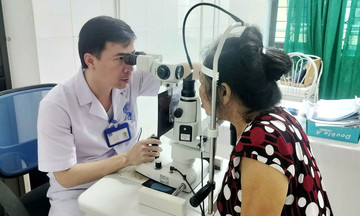An ultrasound at Tam Anh General Hospital in Ho Chi Minh City revealed two gallstones in Thanh’s gallbladder, one measuring over 2 cm, along with biliary sludge and cholesterol adhering to the gallbladder wall. Dr. Pham Cong Khanh, Head of the Hepatobiliary and Pancreatic Department at the Endoscopy and Minimally Invasive Digestive Surgery Center, explained that the large gallstone blocked the bile duct, preventing bile flow and increasing pressure in the gallbladder, causing the patient's severe pain.
 |
Dr. Khanh (left) performs laparoscopic gallbladder removal on Thanh. Photo: Tam Anh General Hospital |
Dr. Khanh (left) performs laparoscopic gallbladder removal on Thanh. Photo: Tam Anh General Hospital
Doctors recommended laparoscopic gallbladder removal to prevent serious complications. The cystic artery was clipped and cauterized, and the gallbladder was removed along with two yellow gallstones measuring 0.8 cm and 2.5 cm. Post-surgery, Thanh's pain subsided, he resumed normal eating and walking, and was discharged after two days.
Gallstones are a common condition, forming due to an imbalance in bile components, particularly excess cholesterol or bilirubin accumulation, leading to precipitation and stone formation. Several factors can increase the risk of gallstones, including a sedentary lifestyle, obesity, a diet high in saturated fat and low in fiber, and rapid weight loss. According to Dr. Khanh, Thanh’s case involved cholesterol stones, formed from excess undissolved cholesterol.
 |
Thanh receives a check-up and instructions before leaving the hospital. Photo: Tam Anh General Hospital |
Thanh receives a check-up and instructions before leaving the hospital. Photo: Tam Anh General Hospital
Gallstone formation is often asymptomatic or presents with vague symptoms easily mistaken for other digestive issues. Gallstones are usually discovered incidentally through abdominal ultrasounds during routine check-ups, pregnancy ultrasounds, or other imaging tests (CT scans, MRIs). If gallstones are asymptomatic, monitoring is necessary, with surgical removal recommended when advised by a doctor. Small stones (3-5 mm) can easily fall into the cystic duct, causing cholecystitis, cholangitis, or acute pancreatitis.
To reduce gallstone formation, Dr. Khanh recommends a healthy diet and lifestyle, including plenty of fiber (vegetables, fruits, and whole grains) and unsaturated fats (fish oil, olive oil). He advises limiting saturated fats and fast food, maintaining a 30-minute daily exercise routine, and avoiding extreme weight loss. Regular check-ups with a Hepatobiliary and Pancreatic specialist are essential for accurate diagnosis, appropriate treatment, and prevention of serious complications.
Quyen Phan
| Readers can submit questions about digestive diseases here for doctors to answer. |












